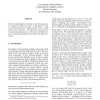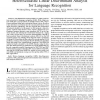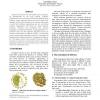6306 search results - page 70 / 1262 » Space, Time, and the Use of Language |
TIME
2008
IEEE
15 years 4 months ago
2008
IEEE
Boolean contact algebras constitute a convenient approach to a region based theory of space. In this paper we want to extend this approach to regions moving in time - called timed...
AGP
2003
IEEE
15 years 3 months ago
2003
IEEE
There are very few approaches to measure the execution costs of lazy functional (logic) programs. The use of a lazy execution mechanism implies that the complexity of an evaluation...
121
click to vote
TASLP
2011
14 years 4 months ago
2011
Abstract—The shifted delta cepstrum (SDC) is a widely used feature extraction for language recognition (LRE). With a high context width due to incorporation of multiple frames, S...
FMSD
2007
14 years 9 months ago
2007
In the classical framework of formal languages, a refinement n is modeled by a substitution and an abstraction by an inverse substitution. These mechanisms have been widely studie...
IWPSE
2005
IEEE
15 years 3 months ago
2005
IEEE
Humans will have to live with software for a long time. As demonstrated by the Y2K problem, computer professionals used a wrong time scale when thinking about software. Large soft...



